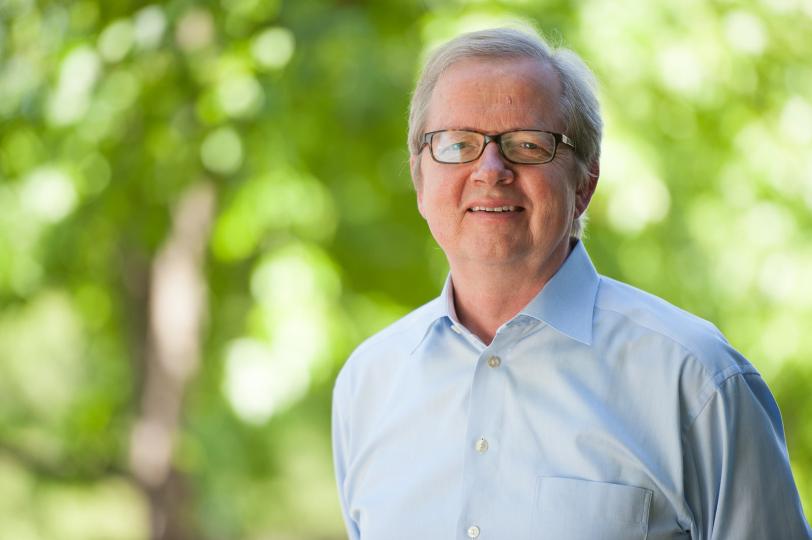SUNCAT Director Jens Nørskov Awarded 2015 Langmuir Prize
SLAC, Stanford Professor Honored for Groundbreaking Work on Catalysis
Jens Nørskov, a professor at Stanford University and the Department of Energy's SLAC National Accelerator Laboratory, will receive the 2015 Irving Langmuir Prize of the American Physical Society for his groundbreaking work on catalysis, which is used to promote chemical reactions in thousands of industrial processes for making fertilizers, fuels, plastics and a host of other products.
The award will be presented at the society’s annual March meeting in San Antonio, Texas.
Nørskov is the Leland T. Edwards Professor of Chemical Engineering at Stanford, a professor of photon science at SLAC and director of the SUNCAT Center for Interface Science and Catalysis, which is jointly run by SLAC and Stanford.
The prize is named for Irving Langmuir, a physical chemist at the General Electric Company who won the 1932 Nobel Prize in chemistry for his work in surface chemistry, and recognizes and encourages outstanding interdisciplinary research in chemistry and physics. In awarding the prize to Nørskov, the APS cited his "ground-breaking contributions to elucidating fundamental principles of reactivity on solid surfaces and the prediction of improved catalysts."
Nørskov came to SLAC and Stanford in 2010 from the Technical University of Denmark, where he was director of the Catalysis for Sustainable Energy Initiative. He holds a master’s degree in physics and chemistry and a PhD in theoretical physics from the University of Aarhus. Very early in his career he became interested in chemical reactions that take place on the surfaces of materials, including catalysts.
Catalysts promote chemical reactions without being consumed themselves. They are cornerstones of the chemical industry, and scientists are constantly looking for ways to make these reactions cheaper and more efficient in their use of energy and materials. They also want to find catalysts that convert renewable energy from sunlight and other sources into useful chemicals, such as fuel and fertilizer. This is a major thrust at SUNCAT.
Working with experimenters and fellow theorists, Nørskov developed a comprehensive theory of how transition metals – which occupy most of the middle of the periodic chart – carry out catalytic reactions. This theory, along with computational methods his group developed, allows scientists to predict which catalysts work best for particular reactions so they can more efficiently make and evaluate potential candidates in a process known as “materials by design.”
Among other things, the approach has led to the discovery of low-cost catalysts for production of methanol and hydrogen fuel. Nørskov’s group also developed the first database of surface chemical properties and created CatApp, a free software application that makes it easier to predict how quickly and completely a catalyzed reaction will proceed.
“I’ve been very fortunate here. We’ve gotten a lot of support from the Department of Energy and others to build up a very strong theory effort with a lot of very good colleagues and also work with some very good experimental groups at Stanford and SLAC,” Nørskov said. “One thing I think SUNCAT does well is to get people together to work on problems single groups couldn’t attack. In that sense, a national lab can be a catalyst for doing bigger things.”
Nørskov has performed research at the Nordic Institute for Theoretical Physics, Haldor Topsøe, IBM T. J. Watson Research Center in New York and the University of Aarhus. He is an author of more than 450 scientific publications and winner of a number of awards, including the Michel Boudart Award from the North American Catalysis Society and the European Federation of Catalysis Societies and the Gabor A. Somorjai Award from the American Chemical Society. He is a fellow of the American Physical Society and a member of the Royal Danish Academy of Science and Letters and the Danish Academy of Engineering.
Contact
For questions or comments, contact the SLAC Office of Communications at communications@slac.stanford.edu.
SLAC is a multi-program laboratory exploring frontier questions in photon science, astrophysics, particle physics and accelerator research. Located in Menlo Park, Calif., SLAC is operated by Stanford University for the U.S. Department of Energy's Office of Science.
SLAC National Accelerator Laboratory is supported by the Office of Science of the U.S. Department of Energy. The Office of Science is the single largest supporter of basic research in the physical sciences in the United States, and is working to address some of the most pressing challenges of our time. For more information, please visit science.energy.gov.






